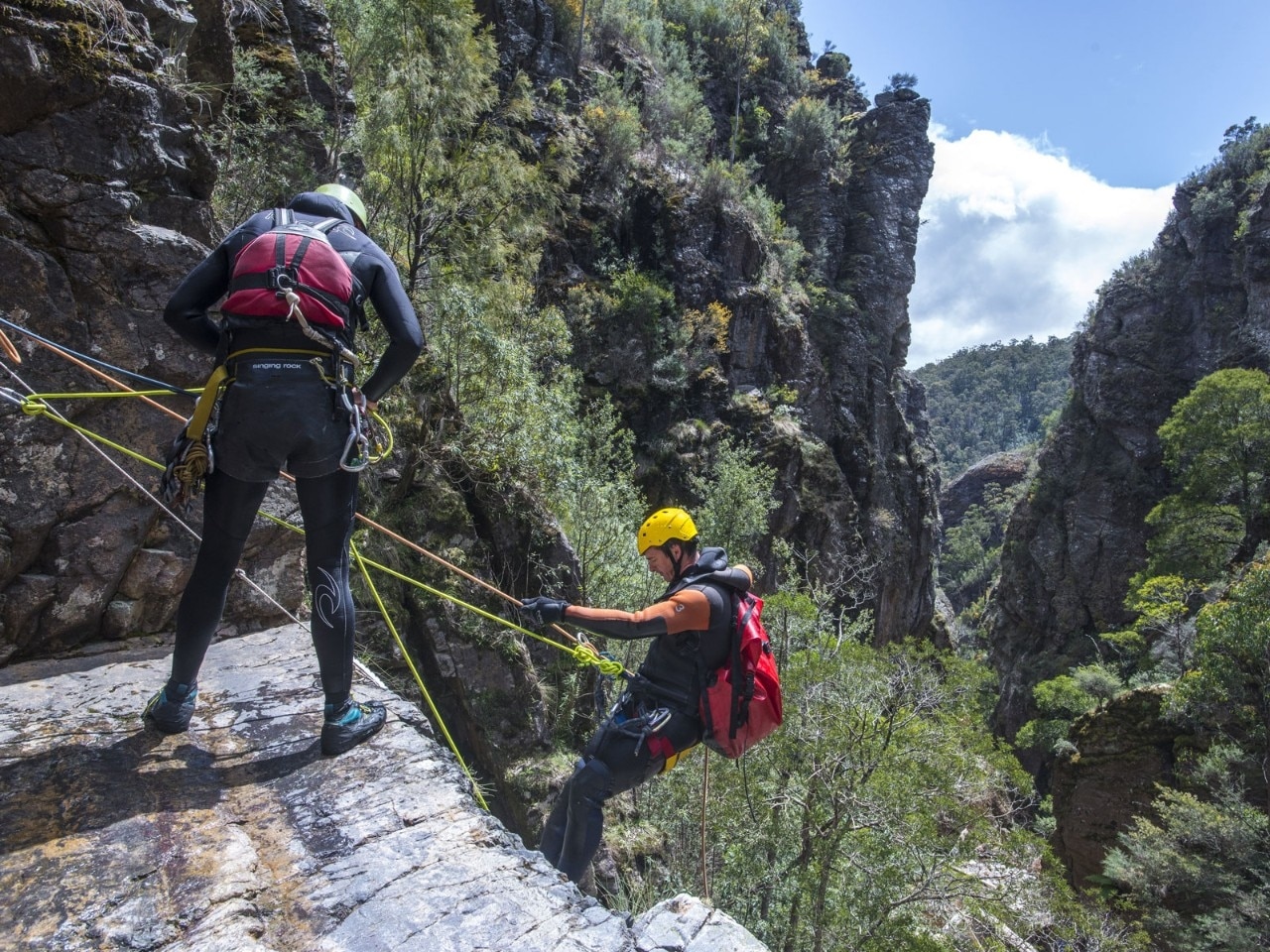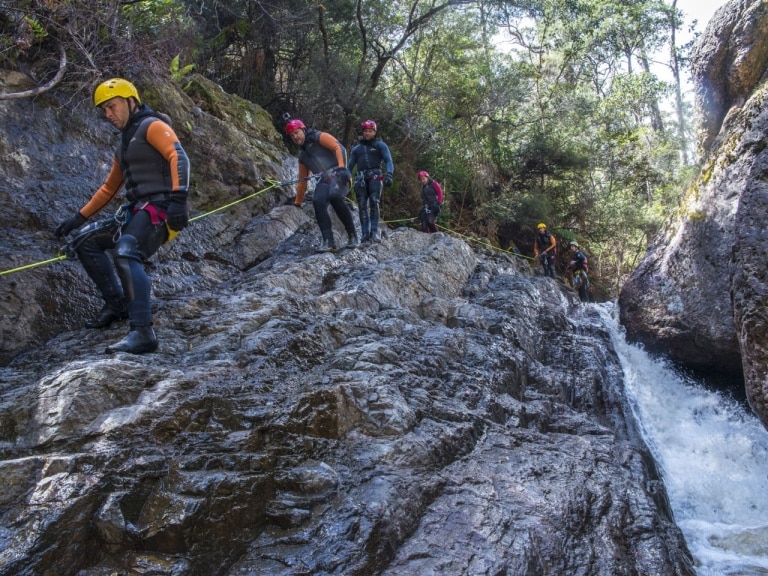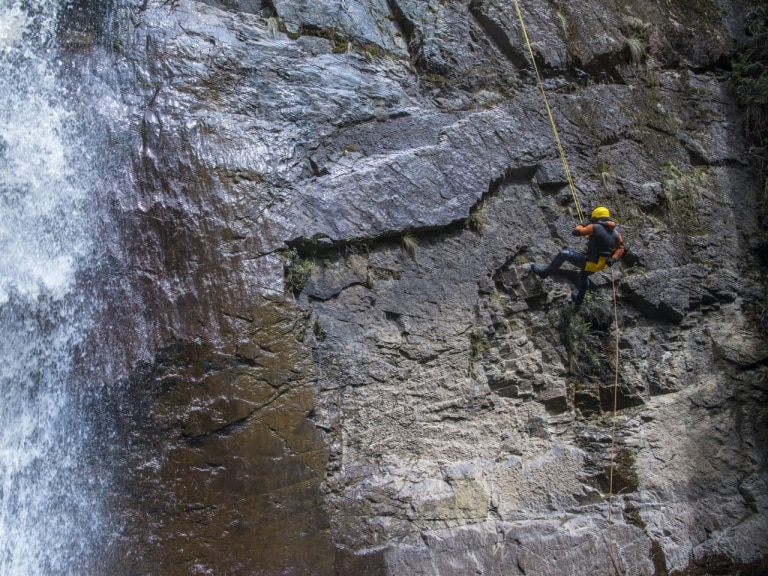Test Your Limits on a Cradle Mountain Canyoning Trip

Five hours, six abseils and one deceptively high waterfall – Andrew Bain gets cold, wet and a little scared in a Cradle Mountain canyon in Tasmania.
To set the scene, let’s start with a name: Petrifying Falls. Known to few people, this powerful waterfall roars out of a hidden canyon near Cradle Mountain in Tasmania, carving itself deep into the cliffs.
On this day, the falls are swollen with overnight rain and snowmelt. Icy water sprays over me as I hang beside them on a rope, abseiling down a cliff that plunges 30 metres into a dark pool of water. At this moment, Petrifying Falls seems like a remarkably apt name.
These falls mark the final and highest abseil of a canyoning trip through Machinery Creek with tour operator Cradle Mountain Canyons. For five hours we’ve been navigating our way through the canyon, wading, jumping, scrambling over boulders and abseiling as we descend beneath enormous cliffs.
SEE ALSO: Mountain-Biking Tasmania’s Blue Derby
In principle, the act of canyoning is simple: find an accessible route into a canyon and then navigate through it by whatever means of progress possible. Physically, it’s as much a puzzle as it is a journey. Emotionally, it’s a concoction of excitement, trepidation, fear and fun.
Canyoning is an activity traditionally associated with places such as New Zealand and the NSW Blue Mountains but it seems a natural fit in a landscape as tortuously folded as Tasmania. It was while running bushwalking tours almost a decade ago that Cradle Mountain Canyons founder Anthony O’Hern began to wonder about such possibilities. He’d regularly walked along the edge of Dove Canyon, among the button-grass plains below Cradle Mountain, but never been able to see into its depths. So one day he gathered some friends and abseiled in.
“We got a huge surprise,” he says. “It just seemed perfect for a commercial activity. It had the [right] combination of being exciting but it could also be run safely.” Less than two years later, he began running guided adventure tours through the canyon.
Dove Canyon remains the company’s signature trip; squeezing through a deep ravine so narrow, there are times you can stretch out your arms and almost touch both walls. Progress through the canyon involves a succession of jumps – leaps of faith – into water from rock ledges up to six metres in height, as well as a few low abseils and the infamous “laundry chute”, a natural water-scoured rock slide that shoots beneath boulders.

Machinery Creek, on the other hand, is an entirely different experience. This canyon, around 30 minutes’ drive from Cradle Valley, is both higher and wider than Dove, stepping down in a series of soaring waterfalls. There are fewer jumps, slides and swims but more abseils to negotiate – and from greater heights. When rain floods Dove Canyon, as it has this day, Machinery Creek inevitably remains passable.
When I visit in November, it’s sleeting in Cradle Valley, while Cradle Mountain is wreathed in snow. Our gear for the day ahead includes three layers of wetsuit as armour against the cold water. “You probably won’t need the hood,” our guide, Leon Bedford, suggests to the group. “You might get too hot.”
There’s a disbelieving silence among the group of canyoners. “I’ll only change between moderately freezing and really freezing,” mutters a man from Brisbane.
The 20-minute hike to the head of Machinery Creek canyon is like a walk through history, following an old mining track that contours across the wooded slopes. Disused mine shafts bore into the cliffs and the canyon plummets away into oblivion beneath us.
When silver was mined here, horses hauled tools and other materials along this track on carts. So much equipment was lost by rolling off into the canyon that Machinery Creek earned its name. Some of the rusted gear can still be seen dotted along the creek and its banks.
As we step into the creek, there are six waterfalls ahead, ranging in height from around 10 to 30 metres. It will take us five hours to cover just 700 metres.
At the head of the group, wading through the tea-coloured water, is Leon, for whom this particular canyon has a special significance. He first scrambled his way through it as a 15-year-old with a bunch of friends, rigging up sketchy abseils from trees at each waterfall.
Five years ago, when Cradle Mountain Canyons was looking to expand its operation beyond Dove Canyon, Leon remembered his teenage journey through Machinery Creek. Potentially, no other person has been through the canyon more times than him. But even for Leon, Machinery Creek is a new puzzle this day.
Heavy flooding across Tasmania last July altered the shape and flow of many waterways, including Machinery Creek. “Everything has changed,” says Leon as we wade towards the first waterfall. “We used to have to climb through boulders everywhere here.” Today we’re stepping over nothing more than small rocks.
We drop into the canyon proper next to a 15-metre waterfall, abseiling into a pool of ice-cold water that seeps through my wetsuit like an anaesthetic. Massive cliffs tower over our heads and the land is strewn with giant boulders. I feel a bit like a hobbit setting out on some kind of fantastical journey.

There are six of us on this trip, plus Leon and fellow guide Alec Wilson. Immediately after me on the rope at this first abseil is Cameron, by far the largest and strongest person in the group. As I watch him unclip at the bottom, he smiles sheepishly. “That got the heart rate up,” he says. “I’m not great with heights.”
Over the next few hundred metres, the canyon steps down in a series of waterfalls. Each one is small in reality but the height is magnified when you’re abseiling over a cliff edge, relying purely on faith and a rope knotted to a harness by your bellybutton.
In between abseils, we slide down the cascades on our bums, scramble over boulders and take small leaps into murky pools. As each abseil is rigged together – in a mysterious but unfailing combination of bolts in the cliffs and knots in the rope – we gravitate to boulders like lizards, basking in the sunlight that now pours into the wide canyon. Eight degrees has never felt so warm.
What surprises me most overall is not the fear, the chill of the water or, next morning, the dull ache in my shoulders from the strain of the abseils. It’s the raw beauty of the terrain. Like so much of Tasmania, Machinery Creek is largely unheralded. I’ve lived in Tasmania for eight years and never heard its name or noticed its presence so near to the main road into Cradle Mountain.
Yet as we wriggle our way through the canyon, there are sections where giant ferns tower over our heads, growing beside cliffs that rise another 150 metres above. A quick set of low abseils in the middle of the canyon takes us beneath a giant boulder, many tonnes in weight, that’s pinned between the canyon walls – its fall towards the canyon floor never completed. It’s a sight as dramatic as anything in the state.
The final waterfall – the one that will deliver us out of the canyon – is Petrifying Falls. Cameron clips in before me, looking nervous again. “The 15-metre abseil was high enough for me,” he says, blowing out his cheeks in resignation. But then he’s gone, over the edge. Within seconds he’s in the pool below, unclipping himself from both the rope and his fear.
I step up to the edge of the falls, which were discovered in the early 19th century by explorer Henry Hellyer, who named them for a fanciful idea that anything that passed through their forceful flow would petrify. After a typo in a local newspaper described them as 300 metres in height – taller than any other waterfall in Australia – they briefly became a cause célèbre, sending people scouring through the bush in search of a mythical giant cascade.
As I begin to step down the sheer cliffs beside the falls, I look between my feet and the world drops away alarmingly. All of a sudden, 30 metres does look rather like 300 metres... 
SEE ALSO: Encounter Great White Sharks in South Australia’s Eyre Peninsula


